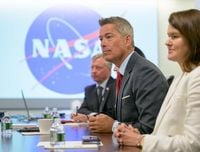The Moon, once the stage for Cold War heroics and iconic flag-planting, is back in the spotlight. But this time, the stakes are different. Instead of a sprint to set boots on lunar soil, the world’s major powers are racing to build something far more enduring—and potentially transformative: nuclear power plants that could energize a new era of lunar exploration and industry. The United States, China, and Russia are all vying to be the first to establish a continuous, high-output energy source on the Moon, with NASA now accelerating its timeline in a bid to outpace its rivals.
On August 4, 2025, acting NASA administrator Sean Duffy issued a landmark directive that scrapped the agency’s existing Fission Surface Power (FSP) plans and launched a new, more ambitious project. The goal? Deliver a 100-kilowatt nuclear fission reactor to the lunar surface by late 2029 or 2030—years ahead of the joint Russia-China plans, which currently target the 2033–2035 window. As reported by POLITICO and Oilprice.com, Duffy didn’t mince words at a press conference: “We’re in a race to the moon, in a race with China to the moon. And to have a base on the moon, we need energy.”
This is no small feat. Back in 2020, NASA’s vision was to build a lunar base and nuclear power plant by 2026, but that timeline quietly slipped. Meanwhile, Russia and China have been making their own moves. In March 2024, Yuri Borisov, head of Russia’s space agency Roscosmos, announced, “Today we are seriously considering a project—somewhere at the turn of 2033-2035—to deliver and install a power unit on the lunar surface together with our Chinese colleagues.” By April 2025, China had publicly unveiled plans to construct a nuclear power plant on the Moon by 2035, intended to support its ambitious international lunar research station.
The new NASA directive calls for a small, focused team—just 15 full-time engineers—tasked with hiring two private companies to design and build the 100kW reactor, with the possibility of down-selecting to a single contractor. The reactor must fit into a 15-metric ton lunar lander, potentially integrated into the lander itself. NASA’s commercial partners, including Lockheed Martin, Westinghouse, and IX (a joint venture of Intuitive Machines and X-energy), had previously been developing smaller 40kW reactors under the old plan. Now, the focus has shifted to scaling up for larger output and faster deployment.
Kevin Au, vice president at Lockheed Martin overseeing lunar projects, told Payload, “The United States has been investing in and working on nuclear space capabilities since the 50s, [but] we haven’t flown anything since 1965.” He added that Lockheed’s 40kW reactor concept could be ready for launch within the decade, but the team is now racing to scale up for the 100kW requirement. The main technical hurdles? Managing heat in the vacuum of space and ensuring that the reactor is safe during its journey to the Moon.
Why the need for so much power? According to Au, it’s all about in-situ resource utilization, or ISRU. The Moon’s south pole is rich in water ice, which can be harvested and refined into oxygen and hydrogen—crucial for life support and rocket fuel. Operating fleets of autonomous harvesters in the perpetual darkness of shadowed craters demands a robust, uninterrupted energy source. Solar just doesn’t cut it: the Moon experiences 14-day nights, and some craters never see sunlight at all. Nuclear power is the only plausible way to keep lunar bases and machinery running around the clock.
The legal and geopolitical dimensions are just as complex as the technical ones. The 1967 Outer Space Treaty, ratified by the U.S., China, and Russia, explicitly prohibits territorial claims on the Moon or any celestial body. But it does allow for the establishment of installations like bases, provided that other countries are consulted beforehand. The United Nations’ 1992 Principles Relevant to the Use of Nuclear Power Sources in Outer Space further set out guidelines for safety, transparency, and international consultation. These frameworks aim to prevent conflict, but they also leave plenty of gray areas. As one space law expert noted in The Conversation, “If one country places a nuclear reactor on the Moon, others must navigate around it, legally and physically. In effect, it draws a line on the lunar map.”
Some analysts worry that a nuclear reactor could be used to establish a de facto exclusion zone, potentially functioning as a territorial claim in all but name. The legal framework may be nonbinding, but the first country to deploy a reactor could set the norms for behavior and interpretation—shaping how access and influence are exercised on the lunar surface for decades to come.
There are also environmental and operational concerns. Even if designed for peaceful use and with all safety protocols followed, reactors introduce new risks, especially in the harsh and unpredictable setting of space. The U.N. guidelines call for rigorous safety standards, and NASA’s plans include extensive consultation and transparency—both to reassure the international community and to avoid any escalation of tensions.
Financially, the challenge is steep. A 2025 paper co-authored by former NASA associate administrator Bhavya Lal estimates that building two demonstrator reactors could cost $2 billion over five years. The paper stresses that success will require NASA to go “all-in” with its commercial partners, warning that “a partial or hybridized model risks repeating past failures and jeopardizing the long-term viability of the space nuclear ecosystem.”
Yet the potential payoff is enormous. A nuclear reactor on the Moon could operate continuously for over a decade, powering habitats, rovers, 3D printers, and life-support systems—not just for the U.S., but for all who participate in lunar science and industry. More importantly, it would lay the groundwork for future missions to Mars, where solar power is even less reliable.
For the United States, the opportunity is as much about leadership and governance as it is about technology. By committing to public transparency, adhering to international guidelines, and emphasizing peaceful, cooperative use, NASA could help set the tone for how lunar infrastructure is built, accessed, and shared. As The Conversation put it, “A reactor on the Moon isn’t a territorial claim or a declaration of war. But it is infrastructure. And infrastructure will be how countries display power—in all kinds—in the next era of space exploration.”
As the world watches this new lunar race unfold, one thing is clear: the contest is no longer about who gets to the Moon first, but about who builds the future there—and how. The next few years will determine not only the technical feasibility of lunar nuclear power, but also the rules of engagement for humanity’s return to deep space.



